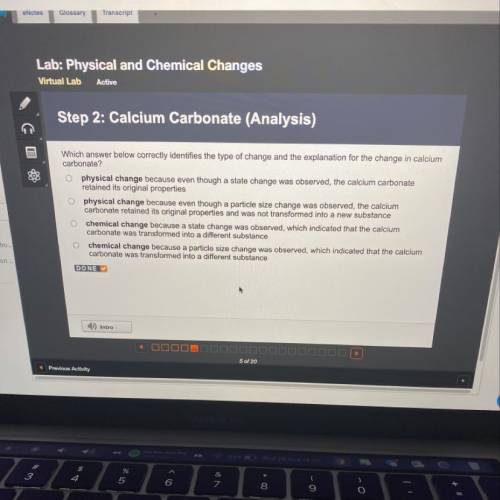
Which answer below correctly identifies the type of change and the explanation for the change in calcium
carbonate?
physical change because even though a state change was observed, the calcium carbonate
retained its original properties
physical change because even though a particle size change was observed, the calcium
carbonate retained its original properties and was not transformed into a new substance
chemical change because a state change was observed, which indicated that the calcium
carbonate was transformed into a different substance
0 chemical change because a particle size change was observed, which indicated that the calcium
carbonate was transformed into a different substance


Answers: 1


Other questions on the subject: Chemistry

Chemistry, 22.06.2019 04:30, EinsteinBro
Which statement best describes the relationship between period and frequency of light waves? a) in wave b the period increases and the frequency decreases from wave a. b) in wave a the period increases and the frequency decreases from wave b. c) in wave b the period is shorter and the frequency is greater than in wave a. d) in wave a the period is shorter and the frequency is greater than in wave b.
Answers: 1


Chemistry, 22.06.2019 17:30, latezwardjr15
In a heat of an engine, if 700 j enters the system, and the piston does 400 j of work what is the final internal (thermal) energy of the system if the initial energy is 1,500 j
Answers: 2

Chemistry, 22.06.2019 18:10, ellemarshall13
Measurements that have similar values are: a. usually accurate b. sometimes accurate c. always accurate d. never accurate
Answers: 1
You know the right answer?
Which answer below correctly identifies the type of change and the explanation for the change in cal...
Questions in other subjects:

English, 18.12.2019 06:31

Mathematics, 18.12.2019 06:31

Chemistry, 18.12.2019 06:31

History, 18.12.2019 06:31


Mathematics, 18.12.2019 06:31

Biology, 18.12.2019 06:31






